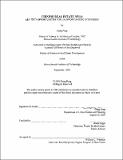Chinese real estate NPLSs : are they opportunities for US opportunistic investors?
Author(s)
Peng, Gang, 1967-
DownloadFull printable version (3.769Mb)
Alternative title
Chinese real estate non-performing loans : are they opportunities for United States opportunistic investors?
Other Contributors
Massachusetts Institute of Technology. Dept. of Urban Studies and Planning.
Advisor
Blake Eagle.
Terms of use
Metadata
Show full item recordAbstract
After explosive development during the early 1990s, China now faces an oversupplied real estate market. State-owned banks, the main financiers of these developments, are burdened with vast amounts of non-performing loans (NPLs). As China prepares for its entry into the World Trade Organization (WTO), it has begun to reform its finance and banking system. Aiming at transforming the state-owned banks into more commercially oriented enterprises, the Chinese government has initiated a major effort to help the banks resolve their NPLs, many of which have been made to real estate development companies. As in the Savings & Loans crisis in the US, within a short period of time a large volume of Chinese non-performing assets will come onto the market. Due to the lack of opportunities in the domestic market, US opportunistic investors are looking to locate high-return investment opportunities in emerging markets. Asia is one of their major targets. US investors have recently acquired billions of dollars worth of Asian real estate NPLs and are looking for more. Would the Chinese non-performing real estate assets be good investment opportunities for US investors? This thesis attempts to answer that question. The research for this thesis was done in three phases. The first phase is an analysis of the US investors' risk-return trade-offs in Asian real estate investment. The purpose is to understand what the US investors look for when they invest in Asian real estate. The second phase is a comparison of China' s investment environment with the environments in other Asian countries, in order to determine China's relative risk profile. The third phase is a study of the objectives and strategies of China's NPL resolution. The goal is to estimate the level of returns China's NPL sales are likely to offer. Interviews with practitioners, including US fund managers, Chinese developers, Chinese bankers, and Chinese real estate academics are the main sources of information. Theoretical research was also conducted to help understand and analyze the information collected from interviews. The interviews and research lead to the following findings: US investments in international real estate are made primarily by Opportunistic Funds. They seek investment opportunities that offer 20-30% returns. Their targeted investment holding periods are between three and five years. Additional returns will be required for each additional layer of risk. China's investment environment is perceived to be riskier than those of other Asian countries by US fund managers. As a result, opportunities in China have to offer higher returns than those of other Asian countries in order to be equally attractive. China's NPL resolution is not likely to be very effective, due to some fundamental flaws built into the political and economic structure of all state-owned entities, including that of the Asset Management Companies, which were set up to resolve NPLs. The thesis concludes that China's NPL resolution is going to be a slow and gradual process, which is not likely to create immediately many high-yielding opportunities that will meet the expectations of US investors. A more distant future, however, may hold more opportunities as China becomes a member of WTO and as pressure builds on the government to sell-off its non-performing assets.
Description
Thesis (S.M.)--Massachusetts Institute of Technology, Dept. of Urban Studies and Planning, 2000. Includes bibliographical references (leaves 75-78).
Date issued
2000Department
Massachusetts Institute of Technology. Department of Urban Studies and PlanningPublisher
Massachusetts Institute of Technology
Keywords
Urban Studies and Planning.